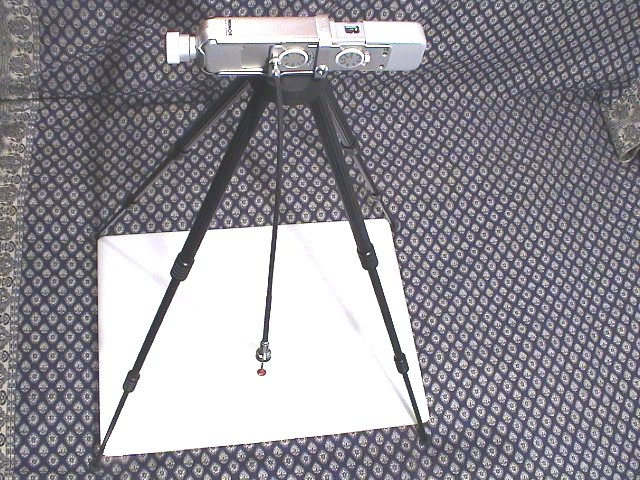
introduction | 50s chrome legs imperial metric | 50s chrome & black legs imperial metric | 60s early imperial metric | 60s late imperial metric | 70s imperial metric | 80s imperial metric | 90s metric
Few subminiature cameras can be used to photograph small objects or documents. Some, like the Minolta MG-s and Yashica Atoron Electro require close up lenses. The Minox, from the first Riga Ur has a close focus of 20cm (8 inches). The dedicated copy stand was introduced at Photokina in 1954.

No special case was made for the copy stand. The four legs and head are easily carried and it is set up very quickly making it idea for copying in libraries, museums or archives. Institutes may have restriction because of copyright issues or because ancient documents have to be handed with white gloves. Strong lights, as in flash or photocopiers may damage the often unique document. Space is also a premium and you may not be allowed to set up the equipment to photograph the object. Take out a Minox and copy stand from your pocket and all practical objections fall to silence. The copyright may not simply be with the document, map or book but 'owned' by the exhibitor. Which means you may have to get approval whether for personal use or for education and research. Available daylight light and longer than normal exposure times avoid the need for flash and resulting glare. The quad-pod also works well against glass cases, although the true distance to the object has to be estimated.
The early copy stands where sold in grey boxes with blue edges. The three leg segments are chrome plated and the feet padded with rubber. Red feet indicate imperial (marks on the legs spaced in inches) and black feet are on metric stands. The position on the legs roughly correspond to DIN A6, A5 and A4 paper sizes. The simple engraved rings give no indication of the focus length which is explained in the accompanying instruction sheet.
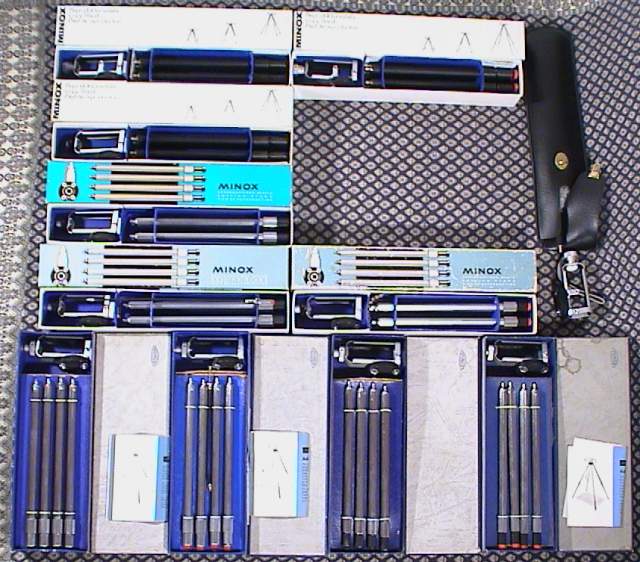
The base of the box have matching red (imperial) or black (metric) circles. Before the change in box style to the 60s bluish green boxes, with a diagram of the content on the top, the two leg extensions where changed to matt black. This reduces stray reflections from the chrome surfaces. Shortly after the top part of the legs where changed from shinny to matt chrome. The four legs of the copy stand are colour coded. These are matched to the colour codes on the head and were adjusted at the factory to make a perfect level fit. The 1954 version have rings for the colour coding. These where replaced by dots at the upper end of the leg. The company style change, to the packing to have a photograph on the top, in 1969 with the introduction of the Minox C saw the new all black legs which dispensed with the need for colour coding.
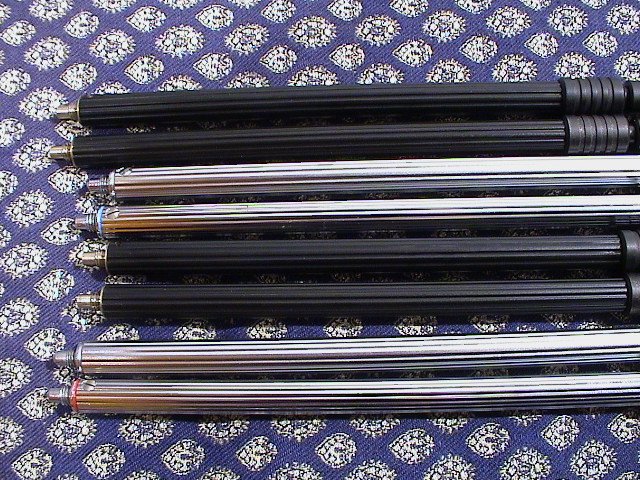
The head of the copy stand has a band in which is a socket for the cable release. No separate cable release was supplied, presumably because it was thought that everyone would have a Minox tripod. The release cable was sold as a replacement part. The end of the head has a thumb wheel that locks the camera into place. At the end of this locking is the 1/4" tripod bush. The final version in the 60s style boxes coincides with the change in the thumb wheel from aluminium to black plastic.
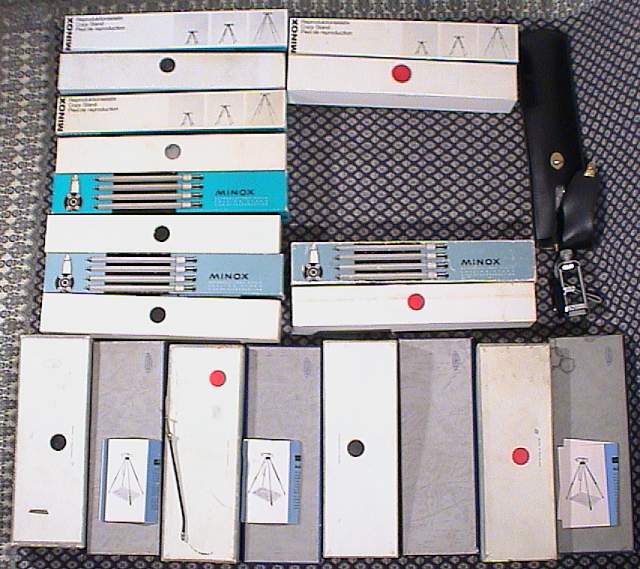
From the 1970s version the legs are all matt black. The twist to tighten locks where replaced by pull back collars that lock by springs. There is no tripod screw thread in this and later models.
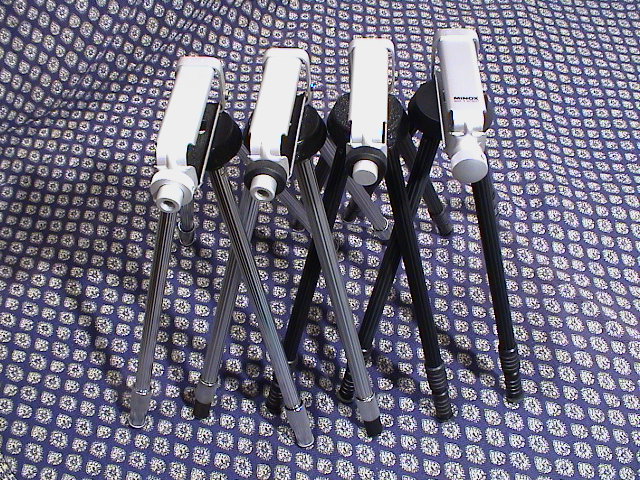
Four styles of copy stand 1950s, 60s, 70s and 80s (LX)
Comparing metric and imperial 1960s style legs (above) and below the metric legs from 1950s, 60s, 70s and 80s with no difference between the 1970s legs and later versions of the copy stand.
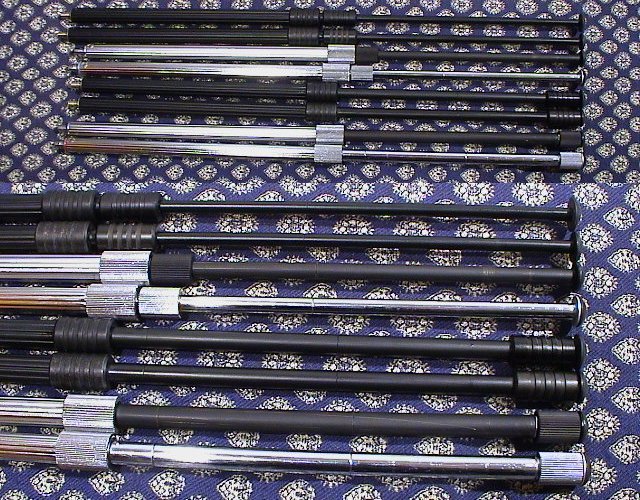
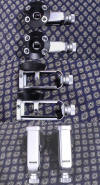 With the introduction of the LX in 1978 the new location for
the shutter released and 1/4" tripod socket required the binocular clamp, tripod
head and copy stand head to be modified. The new knurled knob has a thread cut
into the connecting post. Mid way along the side a second position for the cable
release was added. This copy stand can be used for the Minox A, B, C, BL, LX and
AX cameras. LX versions of the copy stand are rare, particularly in
imperial (red feet). Rarest of all appear to be imperial 1970s (blue box with
photograph on the top) version. A red box 1980s version has not been seen.
Factory new copy stand stand supplied in 2000 where delivered in a huge plain
brown box with a poor photocopy of the 1978 instruction sheet.
With the introduction of the LX in 1978 the new location for
the shutter released and 1/4" tripod socket required the binocular clamp, tripod
head and copy stand head to be modified. The new knurled knob has a thread cut
into the connecting post. Mid way along the side a second position for the cable
release was added. This copy stand can be used for the Minox A, B, C, BL, LX and
AX cameras. LX versions of the copy stand are rare, particularly in
imperial (red feet). Rarest of all appear to be imperial 1970s (blue box with
photograph on the top) version. A red box 1980s version has not been seen.
Factory new copy stand stand supplied in 2000 where delivered in a huge plain
brown box with a poor photocopy of the 1978 instruction sheet.
The LX copy stand head also has a screw thread in the black collar to which the legs are screwed. There is no note in the instructions about this. The 1978 instructions have a note about the LX but the photographs show the earlier 1970s copy stand with a Minox C. As the LX lacks the raise rim of the earlier modes the filters for the A, B, C and BL cameras will not fit. The jaws of the binocular attachment can be used to clamp a standard 35mm filter in front of the lens. The equally bulky copy stand head, of this version, can be used for the same purpose.
Minox have made separate copy stands for metric and imperial cameras. The rings (grooves) on the legs are at different distances from the collar/locks and the red feet of the imperial version are thicker than the black feet of the metric version. Although it is possible to use any stand with any camera by manually setting and adjusting the length of the legs the collar will not lock into place. The photographs below graphically demonstrate the slight differences in the position of the markings, imperial upper most, metric at the bottom and a centimetre tape measure between them. A ball point pen points to the metric scale marks. The tape measure scale does does not relate to the focal length. For example the 20cm focal length requires the legs to be fully retracted where as the 19/19.5cm of the fully extended position relates to when both legs extensions are pulled out. See the instruction sheets.
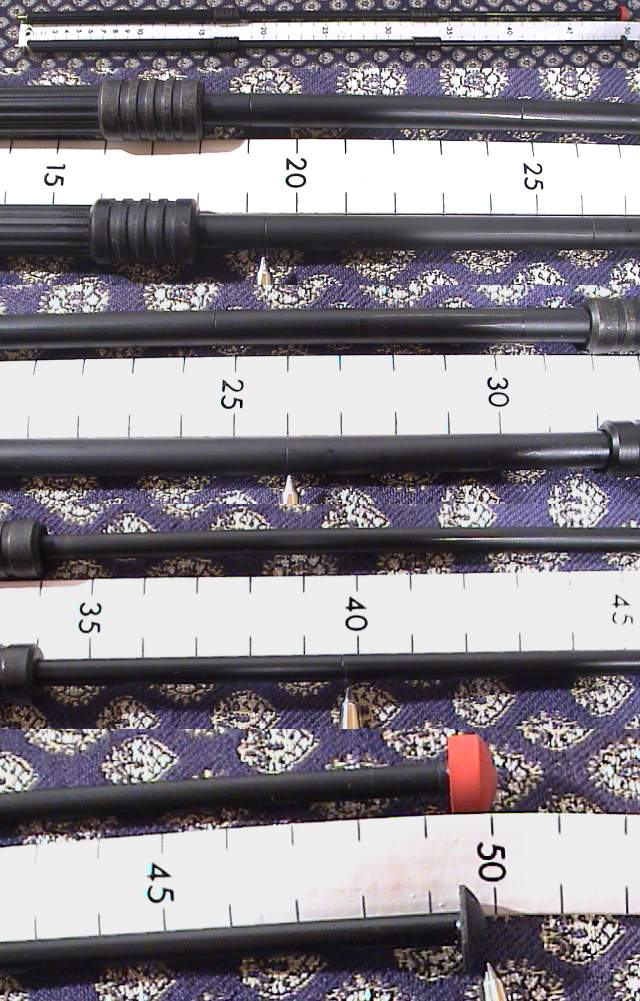
Last Updated on 10th June 2007